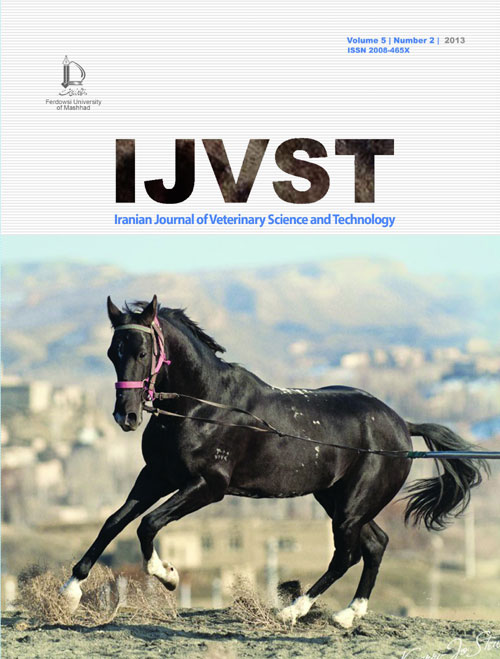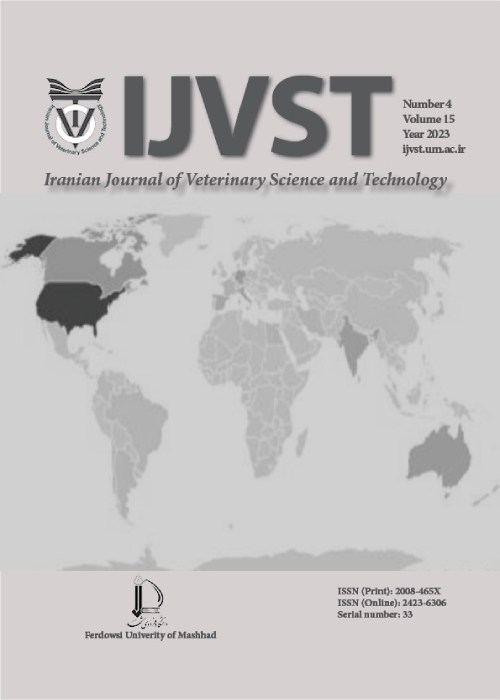فهرست مطالب

Iranian Journal of Veterinary Science and Technology
Volume:5 Issue: 2, Summer and Autumn 2013
- تاریخ انتشار: 1392/11/12
- تعداد عناوین: 7
-
Pages 1-8Cobalt is an essential co-factor in red blood cell production and function and its deficiency may produce clinical signs in sheep. Thus، present study was designed to evaluate the effect of cobalt nano-particles on serum biochemical factors and histopathological changes in liver and kidnies of lambs. Study was carried out in 3 groups of lambs (4 lambs per group). One group of lambs was kept as control group. Second and third group respectively received cobalt nano-particles and conventional cobalt chloride suspension daily for a period 25 day. Blood sample and then serum was collected before and at the end of study. Activity of ALT، AST، ALP and level of BUN، creatinine and vitamin B12 were measured in serum of lambs. Tissue sections of liver and kidney were stained with hematoxylin and eosin and examined by light microscopy. Activity of ALT، BUN and vitamin B12 was significantly increased by cobalt nano-particles and conventional cobalt chloride. Fatty change of hepatocytes occured by conventional cobalt and granulomatous hepatitis، focal necrosis of hepatocytes and degeneration of hepatocytes by the nano cobalt was identified in liver. There were not any significant lesions and alteration in the kidnies of treated groups. Thus، cobalt nano particles have similar effect to conventional cobalt for using in sheep with cobalt deficiency.Keywords: Cobalt nano, particles, hepatotoxicity, renal toxicity, lamb
-
Pages 9-18This study was conducted to evaluate the effect of dietary melatonin supplementation (10 mg/kg body wt. for 4 weeks) on some erythrocytic antioxidant enzymes and lipid peroxidation as well as some plasma biochemical parameters in common carp. The results showed that the activities of glutathione peroxidase and superoxide dismutase were increased significantly (p < 0. 05) after melatonin supplementation، whereas alterations in catalase activity were not significant. Malondildehyde concentrations in erythrocyte hemolysate were decreased significantly as a result of melatonin treatment. Plasma biochemical analysis revealed a significant decrease of glucose، cholesterol، albumin and triglyceride، in addition to a significant increase in total protein، AST and ALP values when compared to the control group. However، alterations in creatinine، urea and LDH levels were not significant following melatonin supplementation compared to the control values. These results offer that pharmacological amounts of melatonin effectively improve erythrocytic oxidative status biomarkers and also alter some plasma biochemical parameters in the common carp that some of them may be undesirable. However، more investigations are required to elucidate the pharmacokinetic effects of melatonin and also possible undesirable effects of high doses of this compound.Keywords: Melatonin, oxidative status biomarkers, biochemical parameters, common carp
-
Pages 19-32Platelets are a natural source of growth factors and cytokines that promote wound healing، and platelet-rich fibrin contains concentrated growth factors. Growth factors in platelet-rich fibrin may promote wound repair. In this study the effect of platelet-rich fibrin was evaluated in a dog model of cutaneous incisional wounds using histology and semi-quantitative evaluation. A pair of ten-centimeter full-thickness parallel linear cutaneous wounds were created on the backs of 15 dogs on the both sides of vertebral column. On the left side the platelet-rich fibrin clot was applied to the edges of the wound (Treatment group) and the right side received nothing (Control group). Allwounds were then closed with 3-0 non-absorbable Nylon suture. The dogs were divided into three groups of five dogs. The wound tissues were sampled by electrosurgery in group one after 3 days، group two after 7 days and group three after 14 days post surgery. For each specimen، histopathological examination and semi-quantitative evaluation was performed by light microscopy using Hematoxylin & Eosin and Masson’s trichrome staining. The results demonstrated that platelet-rich fibrin improved and accelerated cutaneous incisional wound healing.Keywords: Platelet, rich fibrin, wound healing, cutaneous wound
-
Pages 33-44This study was conducted to determine the effects of administration of different concentration of Aloe vera Crud Extract (ACE) as a food supplement on growthperformance, immune response and disease resistance against Aeromonas hydrophila (Chester) infection in Cyprinus carpio. 360 juvenile C.carpio were randomly divided intofour equal groups in triplicates. Groups 1 to 4 were fed by basal food supplemented with zero, 0.1, 0.5 and 1% ACE respectively, for 60 days. At the end of the experimental period growth performance indices including: SpecificGrowth Rate (SGR), Food Conversion Rate (FCR), Food Efficacy Rate (FER) and Percentage Weight-Gain (PWG) were evaluated. Blood samples were taken from each treatment and Haematological parameters including: Red Blood Cells (RBC) & White Blood Cell(WBC) count, differential count, Hemoglobin (Hb), Hematocrit (Hct), Mean Corpuscular Volume (MCV), Mean Corpuscular Hemoglobin (MCH) and the Mean Corpuscular Hemoglobin Concentration (MCHC) as well as Immunological parameters including: lysozyme activity, serum bactericidal activity, alternative complement activity, respiratory burst activity, serum total protein and globulin were evaluated. Finally challenge with Aeromonas hydrophila was performed and commutative mortality was calculated. Results showed significant improve in growth indices of groups 3 and 4 (p<0.05). PCV and MCV, as well as most of the immune parameters including, lysozyme activity, complement activity, respiratory burst activity and serum bactericidal activity were significantly (p<0.05) higher in groups 3 and 4. In addition the rate of challenge mortality was significantly lower in the 0.5 and 1% ACE treated fishes than other groups (p 0.05). In conclusion supplementation of food with 0.5 and 1% ACE has immunostimulating, growth stimulation effects, as well as resistance against bacterial infection in C.carpio.Keywords: Aloe vera extract, Cyprinus carpio, Aeromonas hydrophila, immunostimulant, hemato, immunological parameters
-
Pages 45-52Equine babesiosis is a hemoprotozoan tickborne disease with worldwide distribution and caused by Theileria equi and Babesia caballi. This study was conducted to determine the seroprevalence of T. equi and B. caballi infection in Turkoman breed horses in North Khorasan Province of Iran. Blood samples were collected from 100 apparently healthy horses and examined by microscopy and indirect immunofluorescent antibody test. T. equi was microscopically detected in five blood smears. Antibodies against T. equi، B. caballi and dual infection were found in 48 (48%)، 2 (2%) and 3 (3%) serum samples، respectively. No significant difference was observed between the seroprevalence of piroplasm infection with risk factors such as age، gender and activity in horses. This is the first report of detection of T. equi and B. caballi infection using IFAT in Iran. It was concluded that the seroprevalence of T. equi infection is higher than B. caballi infection in Turkoman breed horse in Iran.Keywords: Theileria equi, Babesia caballi, Indirect immunofluorescent antibody test, Turkoman breed horse
-
Pages 53-61BVDV and BHV-1 are considered as worldwide، complicated and economically significant infections associated with a range of clinical syndromes in cattle. As clinical syndromes such as pneumonia، diarrhea، abortion and reproductive losses were repeatedly reported in dairy herds in suburbs of Arak، this study was planned to determine the prevalence of antibodies to BVDV and BHV-1 in industrial dairy herds in the region. For this purpose، a total of 803 serum samples from 12 non-vaccinated herds were collected between June to October 2008 and evaluated for BVDV and BHV-1 antibodies using commercially available ELISA kits. Antibodies were detected against BVDV in all herds، but only one herd was free from BHV-1. The prevalence rate of 54. 3% and 35. 6% was estimated for BVDV and BHV-1، respectively. In addition، statistical analysis showed significant associated seropositivtiy to both infections. The results notably exhibited that both BHV-1 and BVDV infections are highly prevalent in the region، indicating that control measures should be implemented to reduce the prevalence rate of these infections.Keywords: BVDV, BHV, 1, seroprevalence, Arak, Iran
-
Pages 62-69Feline calicivirus (FCV) is a highly infectious respiratory pathogen of domestic cats with a widespread distribution. In order to assess how FCV circulates in feral and household cats، we have carried out the first study on the FCV detection in Ahvaz district from December 2008 to November 2009. Oropharyngeal، nasal and ocular swabs of one hundred cats (70 feral and 30 household) were evaluated by reverse transcription polymerase chain reaction (RT-PCR) procedure for the detection of FCV. The influence of sex، age، social status and clinical signs on the probability of infection was analyzed using statistical Fisher’s exact test. Overall، feline calicivirus was detected in 4/100 (4%) of sampled cats; 13. 3% of the household cats were FCV positive compared to 0% of feral cats. According to several factors including younger cats (under 6 months of age)، multiple cat household and clinical findings، differences were significant (p<0. 05) in statistical analysis. There was no significant difference between the sex distributions of the cats (p>0. 05). To the best of our knowledge، this is the first report indicating the presence of FCV in cats in Iran. Due to low prevalence of FCV infection and the fact that feral cats live solitarily، it was concluded that this viral infection don’t spread readily within feral populations. However special measures are recommended to avoid infection of susceptible and unvaccinated cats.Keywords: Feline calicivirus, Feline viral respiratory infections, Iran, RT, PCR


